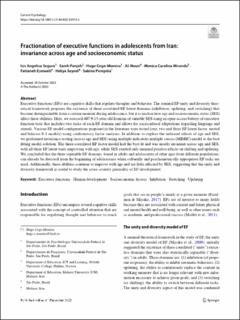| dc.description.abstract | Executive functions (EFs) are cognitive skills that regulate thoughts and behavior. The seminal EF unity and diversity theoretical framework proposes the existence of three correlated EF latent domains (inhibition, updating, and switching) that become distinguishable from a certain moment during adolescence, but it is unclear how age and socioeconomic status (SES) afect these abilities. Here, we assessed 407 9-15-year-old Iranians of variable SES using an open-access battery of executive function tests that includes two tasks of each EF domain and allows for sociocultural adaptations regarding language and stimuli. Various EF model confgurations proposed in the literature were tested (one, two and three EF latent factor, nested
and bifactor-S-1 models) using confrmatory factor analyses. In addition, to explore the unbiased efects of age and SES, we performed invariance testing (across age and SES) using multiple indicators multiple causes (MIMIC) model to the best ftting model solution. The three-correlated EF factor model had the best ft and was mostly invariant across age and SES, with all three EF latent traits improving with age, while SES exerted only minimal positive efects on shifting and updating. We concluded that the three separable EF domains, found in adults and adolescents of other ages from diferent populations, can already be detected from the beginning of adolescence when culturally and psychometrically appropriate EF tasks are used. Additionally, these abilities continue to improve with age and are little afected by SES, suggesting that the unity and diversity framework is useful to study the cross-country generality of EF development. | en_US |

